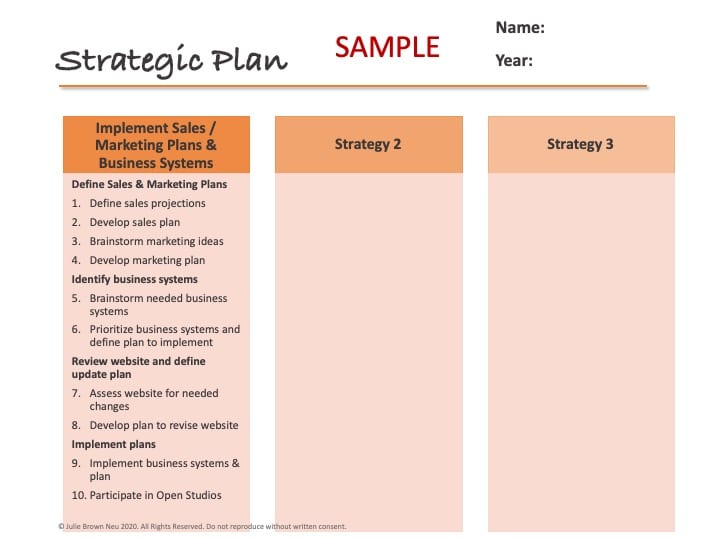I have been thinking a lot about vision and strategy over the last few months. One reason for that is that I’m reflecting about what’s really important during this great pause in life brought on by a global pandemic. I think that the other reason is that I’m not making much headway in my day job on getting others to think about strategy so I figure I might as well make progress on a strategy for my creative practice. I hope that you’re finding this strategic planning rabbit hole useful too as you think about your own practice.
Last month, I wrote about what a strategy is and gave you a template for tying your vision to three strategic priorities. This month, it’s time to take that work one step further and define a plan and a roadmap. Without a plan and a roadmap, a strategy is just a nice idea. But, with a plan and a roadmap, you can actually make something happen.In the template this month, I’ve included a sample plan and roadmap to help make this idea a little more concrete. You’ll see that it’s not pages and pages of detail and that a strategic plan does not need to be any more detailed than 10 steps. Since you’re not drafting a strategy for eliminating racial injustice, the plan for your creative practice strategy should be short and sweet. If you find yourself writing more than a dozen tasks under a single strategic priority, maybe you actually have a couple of strategies commingled that should be teased apart.
So, start by writing the three strategic priorities you identified last month in the header boxes of the three orange rectangles. Under each one, list out the tasks you’ll need to complete to reach your strategic goal. If it helps, group them into major buckets of work. Then, turn to the roadmap template. Decide what matters most – having a deadline or fitting the work into your life. If it’s the deadline that’s most important, start there. Figure out when you want to have your goal accomplished and then back into when each task needs to be completed to get you to your goal on time. If it matters most to complete the work in the most reasonable way, plot out the tasks based on when you can likely get them done and then see where you’ll end up. Put your time frame across the top of the roadmap template, using weeks, months, or quarters as appropriate for your goals. Label each the orange bars with one of your strategic priorities and write the tasks for each as they fit on the schedule. As a final step, take a look at the roadmap and make sure it’s feasible. Once you have all of the tasks on it, you may realize that you’ve scheduled two major tasks to happen at the same time and it’s when you’ve planned a vacation. Fix that to set yourself up for success and let your roadmap be your guide as you move ever closer to achieving your goals.
Want this content sent directly to your inbox each month, along with exclusive creativity prompts and news from my studio? Sign up for the Creative Play™ Newsletter here.




